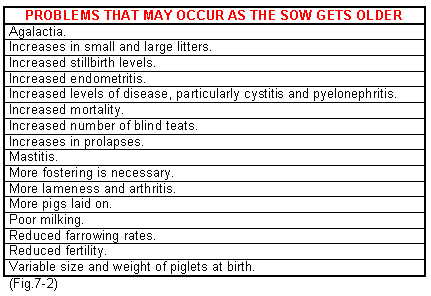



Reasons for sow disposal
Up to 50% of all sows culled from a herd are usually associated with some form of reproductive failure or poor performance. Lameness and mortality also may be significant causes of failure. By collecting and studying such information the excessive areas of loss are identified. When farrowing rates are less then 85% it should be possible to identify significant losses and take the corrective action. It has always been a point of debate how old the sow should be before she leaves the herd but the following should be taken into account when making a decision.
- Age and its effects on the individual sows' production.
- Individual record and history.
- Maintaining the mating programme.
- The availability of gilts.
- The performance of the sow compared to that of a gilt.
- Health of the sow - e.g. arthritis.
- Body condition.
With increasing age the performance of the sow will decrease as shown in Fig.7-2. On most farms sows should be culled after they have had between 6 and 10 litters, the majority after the sixth pregnancy.








